Management of Dredging Activities in a Highly Vulnerable Site: Simulation Modelling and Monitoring Activity
Abstract
:1. Introduction
2. Materials and Methods
2.1. Study Site
2.2. Environmental Monitoring Action
3. Numerical Simulation
3.1. Modelling of Marine Currents and Calibration
3.2. Mud Transport Modelling
4. Results
Sea Circulation and Sediment Plume Dynamics
5. Discussion
Detecting Sensitive Areas around the Dredging Site
6. Conclusions
Author Contributions
Funding
Acknowledgments
Conflicts of Interest
References
- Demars, K.R.; Richardson, G.N.; Raymond, N.Y.; Ronald, C. Remediation, and Containment of Contaminated Sediments; ASTM International: West Conshohocken, PA, USA, 1995. [Google Scholar]
- John, S.A. Scoping the Assessment of Sediment Plumes from Dredging; CIRIA: London, UK, 2000. [Google Scholar]
- Palermo, M.R.; Averett, D.E. Environmental dredging—A state of the art review. In Proceedings of the 2nd International Symposium on Contaminated Sediments: Characterization, Evaluation, Mitigation/Restoration, Management Strategy Performance, Quebec City, QC, Canada, 26–28 May 2003; pp. 12–17. [Google Scholar]
- US Army Corps of Engineers (USACE). A Review of Environmentally Improved Techniques for Dredging Contaminated Mud; TECHNICAL NOTE TN 3/2003; Fill Management Division GEO: Hong Kong, China, 2003; p. 29.
- Eisma, D. Dredging in Coastal Water; Taylor & Francis Publishing: London, UK, 2006; p. 244. ISBN 978-0-415-39111-5. [Google Scholar]
- Bridges, T.S.; Gustavson, K.E.; Schroeder, P.; Ells, S.J.; Hayes, D.; Nadeau, S.C.; Palermo, M.R.; Patmont, C. Dredging processes and remedy effectiveness: Relationship to the 4 Rs of environmental dredging. Integr. Environ. Assess. Manag. 2010, 6, 619–630. [Google Scholar] [CrossRef] [PubMed]
- Chimienti, G.; De Padova, D.; Mossa, M.; Mastrototaro, F. A mesophotic black coral forest in the Adriatic Sea. Sci. Rep. 2020, 10, 8504. [Google Scholar] [CrossRef] [PubMed]
- De Carolis, G.; Adamo, M.; Pasquariello, G.; De Padova, D.; Mossa, M. Quantitative characterization of marine oil slick by satellite near-infrared imagery and oil drift modelling: The Fun Shai Hai case study. Int. J. Remote Sens. 2013, 34, 1838–1854. [Google Scholar] [CrossRef]
- De Padova, D.; Mossa, M.; Adamo, M.; De Carolis, G.; Pasquariello, G. Synergistic use of an oil drift model and remote sensing observations for oil spill monitoring. Environ. Sci. Pollut. Res. 2017, 24, 5530–5543. [Google Scholar] [CrossRef]
- Armenio, E.; Ben Meftah, M.; De Padova, D.; De Serio, F.; Mossa, M. Monitoring System in Mar Grande Basin (Ionian Sea). In Proceedings of the IEEE International Workshop on Metrology for the Sea, Learning to Measure Sea Health Parameters (Metrosea), Bari, Italy, 8–10 October 2019; pp. 104–109. [Google Scholar] [CrossRef]
- Armenio, E.; Ben Meftah, M.; De Padova, D.; De Serio, F.; Mossa, M. Monitoring Systems and Numerical Models to Study Coastal Sites. Sensors 2019, 19, 1552. [Google Scholar] [CrossRef] [Green Version]
- Great Barrier Reef Marine Park Authority (GBRMPA). Guidelines: The Use of Hydrodynamic Numerical Modelling for Dredging Projects in the Great Barrier Reef Marine Park; Great Barrier Reef Marine Park Authority (GBRMPA): Townsville, Australia, 2012; p. 8. Available online: http://hdl.handle.net/11017/970 (accessed on 10 October 2020).
- Lisco, S.; Corselli, C.; De Giosa, F.; Mastronuzzi, G.; Moretti, M.; Siniscalchi, A.; Marchese, F.; Bracchi, V.; Tessarolo, C.; Tursi, A. Geology of Mar Piccolo, Taranto (southern Italy): The physical basis for remediation of a polluted marine area. J. Maps 2016, 12, 173–180. [Google Scholar] [CrossRef] [Green Version]
- Sollecito, F.; Cotecchia, F.; Mali, M.; Miccoli, D.; Vitone, C. Geo-chemo-mechanical characterization of a polluted marine basin. E3S Web Conf. 2019, 92, 18001. [Google Scholar] [CrossRef]
- De Serio, F.; Armenio, E.; Ben Meftah, M.; Capasso, G.; Corbelli, V.; De Padova, D.; De Pascalis, F.; Di Bernardino, A.; Leuzzi, G.; Monti, P.; et al. Detecting sensitive areas in confined shallow basins. Environ. Model. Softw. 2020, 126, 104659. [Google Scholar] [CrossRef]
- Labianca, C.; De Gisi, S.; Todaro, F.; Notarnicola, M. DPSIR model applied to the remediation of contaminated sites. A case study: Mar Piccolo of Taranto. Appl. Sci. 2020, 10, 5080. [Google Scholar] [CrossRef]
- Cardellicchio, N.; Annicchiarico, C.; Di Leo, A.; Giandomenicom, S.; Spada, L. The Mar Piccolo of Taranto: An interesting marine ecosystem for the environmental problems studies. Environ. Sci. Pollut. Res. 2016, 23, 12495–12501. [Google Scholar] [CrossRef]
- Vatova, A. Osservazioni fisico chimiche periodiche nel Mar Grande e Mar Piccolo di Taranto (1962–1969). Boll. Pesca Piscic. Idrobiol. 1972, XXVII, 43–79. [Google Scholar]
- Cerruti, A. Le sorgenti sottomarine (Citri) del Mar Grande e nel Mar Piccolo di Taranto; Annali Istituto Superiore Navale: Napoli, Italy, 1948; Volume 7, pp. 171–196. [Google Scholar]
- Strusi, A.; Pastore, M. Osservazioni idrografiche del Mar Grande e nel Mar Piccolo di Taranto. Campagna 1970–71. Oebalia 1975, 17, 1–64. [Google Scholar]
- De Serio, F.; Mossa, M. Environmental monitoring in the Mar Grande basin (Ionian Sea, Southern Italy). J. Environ. Sci. Pollut. Res. 2016, 23, 12662–12674. [Google Scholar] [CrossRef] [PubMed]
- De Serio, F.; Mossa, M. Assessment of hydrodynamics, biochemical parameters and eddy diffusivity in a semi-enclosed Ionian basin. Deep Sea Res. Part II Top. Stud. Oceanogr. 2016, 133, 176–185. [Google Scholar] [CrossRef]
- Armenio, E.; Ben Meftah, M.; Bruno, M.F.; De Padova, D.; De Pascalis, F.; De Serio, F.; Di Bernardino, A.; Mossa, M.; Leuzzi, G.; Monti, P. Semi enclosed basin monitoring and analysis of meteo, wave, tide and current data. In Proceedings of the IEEE Conference on Environmental, Energy and Structural Monitoring Systems, Bari, Italy, 13–14 June 2016. [Google Scholar] [CrossRef]
- Armenio, E.; De Serio, F.; Mossa, M. Analysis of data characterizing tide and current fluxes in coastal basins. Hydrol. Earth Syst. Sci. 2017, 21, 3441–3454. [Google Scholar] [CrossRef] [Green Version]
- Armenio, E.; De Serio, F.; Mossa, M.; De Padova, D. Monitoring system for the sea: Analysis of meteo, wave and current data. In Proceedings of the IMEKO TC19 Workshop on Metrology for the Sea, MetroSea: Learning to Measure Sea Health Parameters, Naples, Italy, 11–13 October 2017; pp. 143–148, ISBN 978-151085211-2. [Google Scholar]
- De Padova, D.; De Serio, F.; Mossa, M.; Armenio, E. Investigation of the current circulation offshore Taranto by using field measurements and numerical model. In Proceedings of the 2017 IEEE International Instrumentation and Measurement Technology Conference, Turin, Italy, 22–25 May 2017; ISBN 978-1-5090-3596-0. [Google Scholar] [CrossRef]
- De Serio, F.; Mossa, M. Meteo and Hydrodynamic Measurements to Detect Physical Processes in Confined Shallow Seas. Sensors 2018, 18, 280. [Google Scholar] [CrossRef] [Green Version]
- DHI. Mike 3 Flow Model: Hydrodynamic Module—Scientific Documentation; DHI Software: Hørsholm, Denmark, 2016. [Google Scholar]
- Simoncelli, S.; Fratianni, C.; Pinardi, N.; Grandi, A.; Drudi, M.; Oddo, P.; Dobricic, S. Mediterranean Sea Physical Reanalysis (CMEMS MED-Physics) [Data Set]. Copernicus Monitoring Environment Marine Service (CMEMS). 2019. Available online: https://doi.org/10.25423/MEDSEA_REANALYSIS_PHYS_006_004 (accessed on 10 October 2020).
- Xie, P.; Arkin, P.A. Global precipitation: A 17-year monthly analysis based on gauge observations, satellite estimates, and numerical model outputs. Bull. Am. Meteorol. Soc. 1997, 78, 2539–2558. [Google Scholar] [CrossRef]
- Rodi, W. Examples of calculation methods for flow and mixing in stratified fluids. J. Geophys. Res. Ocean. 1987, 92, 5305–5328. [Google Scholar] [CrossRef]
- Smagorinsky, J. Large eddy simulation of complex engineering and geophysical flows. In Evolution of Physical Oceanography; Galperin, B., Orszag, S.A., Eds.; Cambridge University Press: New York, NY, USA, 1993; pp. 3–36. [Google Scholar]
- Partheniades, E. Erosion and deposition of cohesive soils. J. Hydraul. Div. 1965, 91, 105–139. [Google Scholar]
- Lumborg, U. Modelling the deposition, erosion, and flux of cohesive sediment through Øresund. J. Mar. Syst. 2005, 56, 179–193. [Google Scholar] [CrossRef]
- USEPA. Contaminated Sediment Remediation Guidance for Hazardous Waste Sites; OSWER 9355.0-85; Office of Solid Waste and Emergency Response, U.S. Environmental Protection Agency: Washington, DC, USA, 2005. Available online: http://www.epa.gov/superfund/resources/sediment/guidance.htm (accessed on 10 October 2020).
- Finch, M.; Fisher, R.; Palmer, A.; Baumgard, A. AnIntegrated Approach to Pipeline Burial in the 21st Century. In Proceedings of the Deep OffshoreTechnology2000 Conference, New Orleans, LA, USA, 7–9 November 2000. [Google Scholar]
- Hayes, D.; Wu, P.Y. Simple approach to TSS source strength estimates. In Proceedings of the Western Dredging Association Twenty-first Technical Conference and Thirty-third Annual Texas A and M Dredging Seminar Special PIANC Session/Texas A and M University, Center for Dredging Studies, Houston, TX, USA, 25 June 2001. [Google Scholar]
- De Serio, F.; Mossa, M. Streamwise velocity profiles in coastal currents. Environ. Fluid Mech. 2014, 14, 895–918. [Google Scholar] [CrossRef]
- De Pascalis, F.; Ghezzo, M.; Umgiesser, G.; De Serio, F.; Mossa, M. Use of SHYFEM open source hydrodynamic model for time scales analysis in a semi-enclosed basin. In Proceedings of the Environmental, Energy, and Structural Monitoring Systems (EESMS), Bari, Italy, 13–14 June 2016; pp. 1–4. [Google Scholar]
- Feola, A.; Lisi, I.; Salmeri, A.; Venti, F.; Pedroncini, A.; Gabellini, M.; Romano, E. Platform of integrated tools to support environmental studies and management of dredging activities. J. Environ. Manag. 2016, 166, 357–373. [Google Scholar] [CrossRef] [PubMed]
- SKM, Sinclair Knight Merz Pty Ltd. Improved Dredge Material Management for the Great Barier Reef Region; Great Barrier Reef Marine Park Authority: Townsville, Australia, 2013.
- Matheron, G. Principles of geostatistics. Econ. Geol. 1963, 58, e1246–e1266. [Google Scholar] [CrossRef]
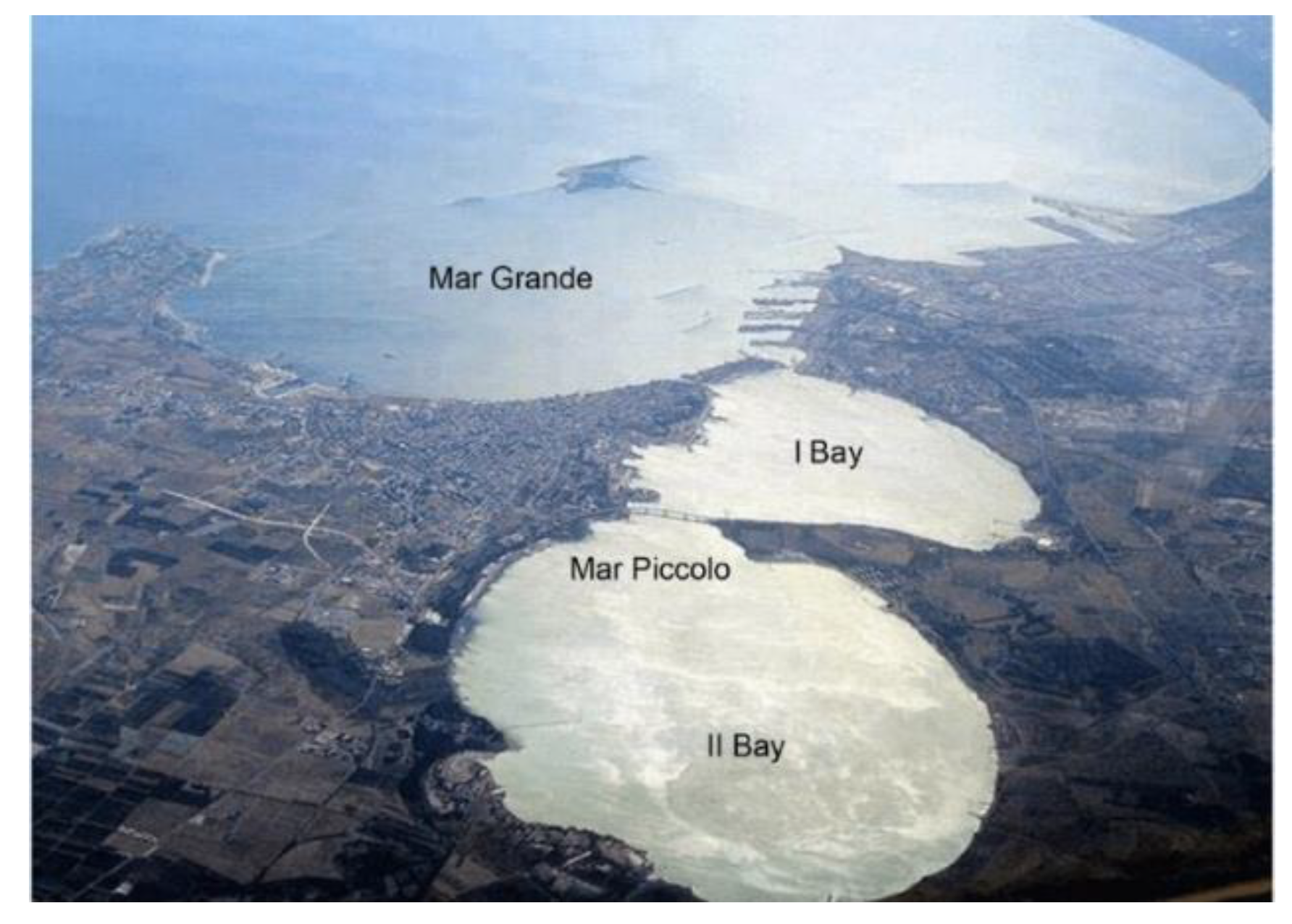

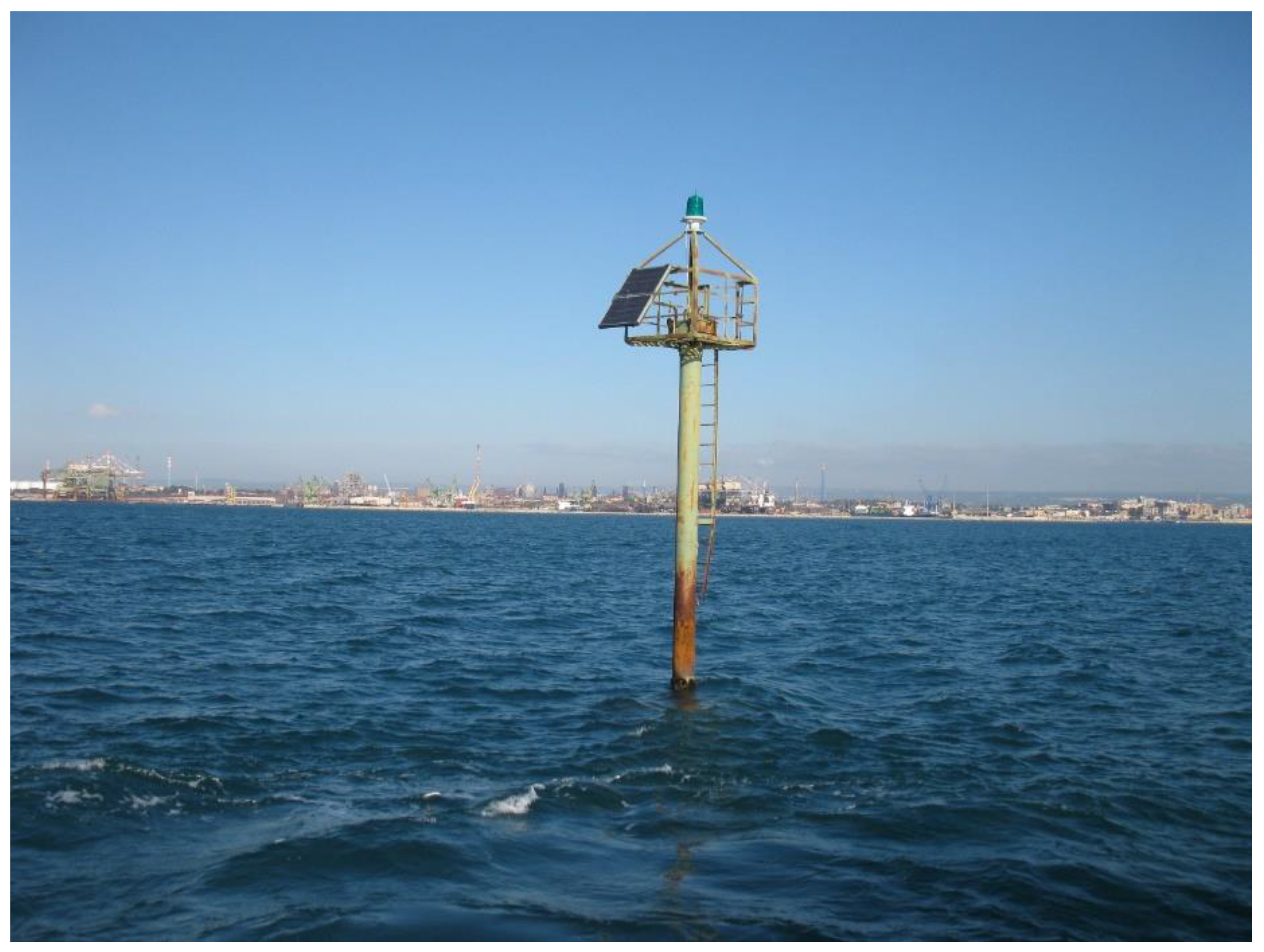
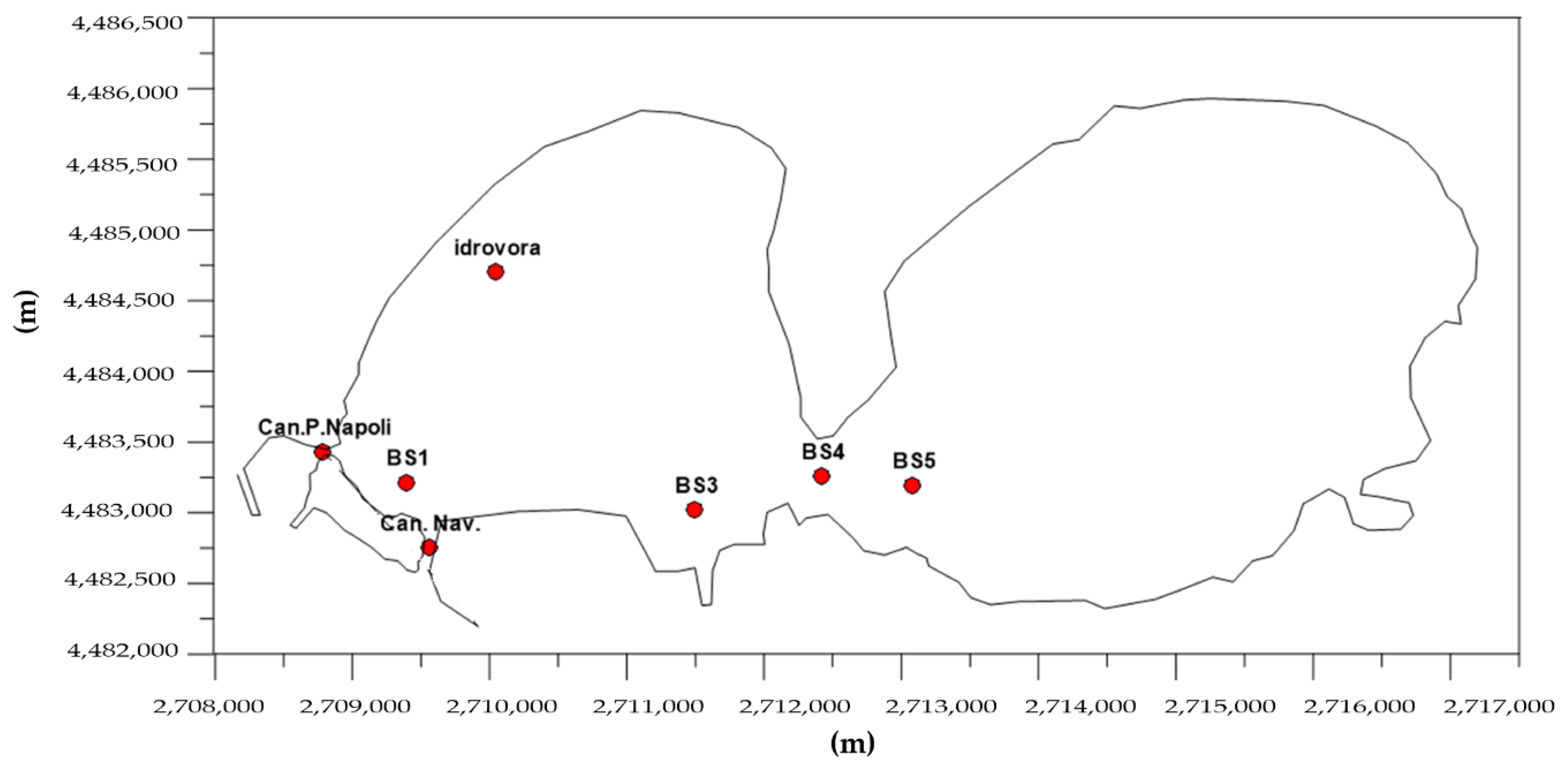
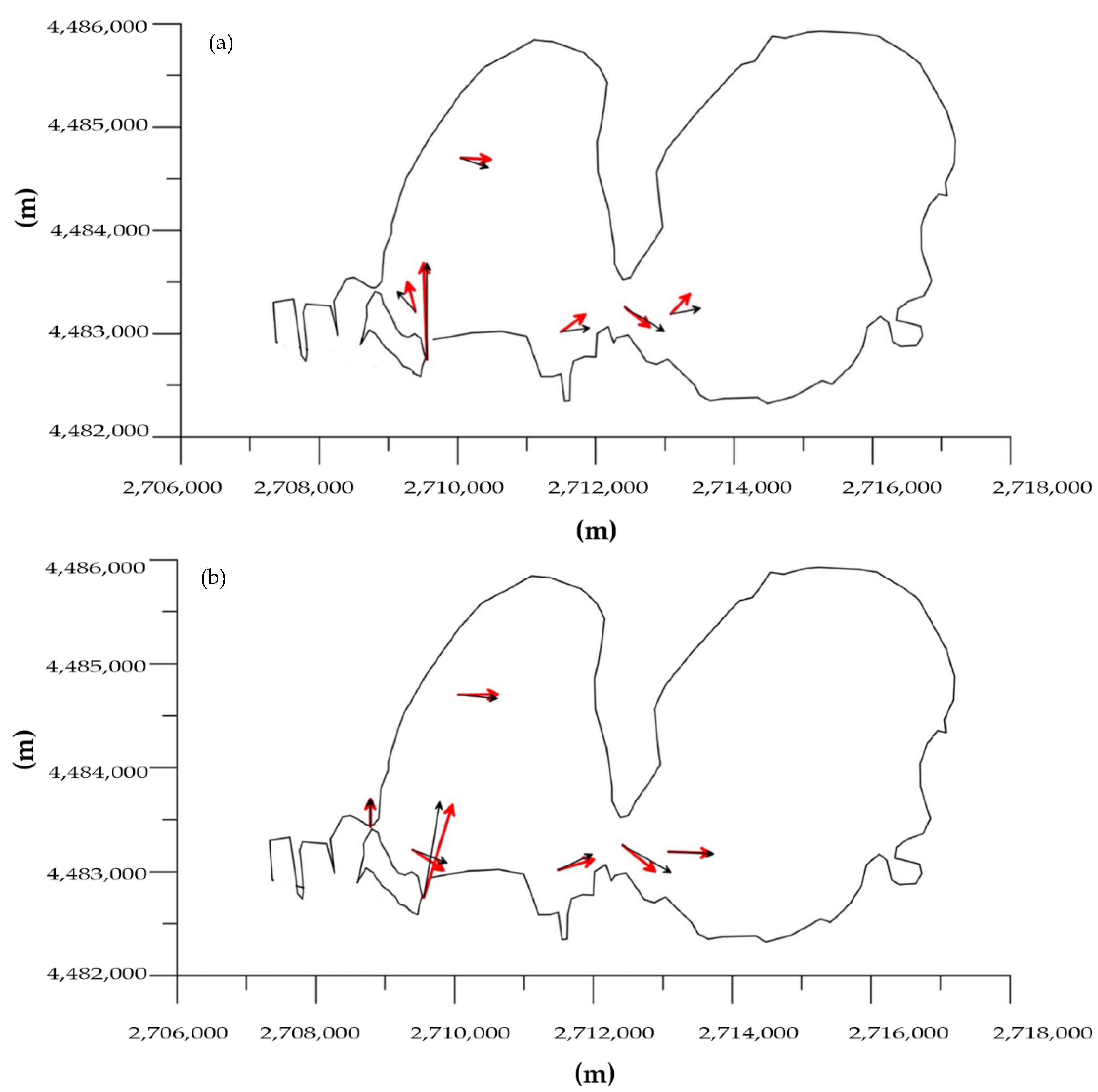

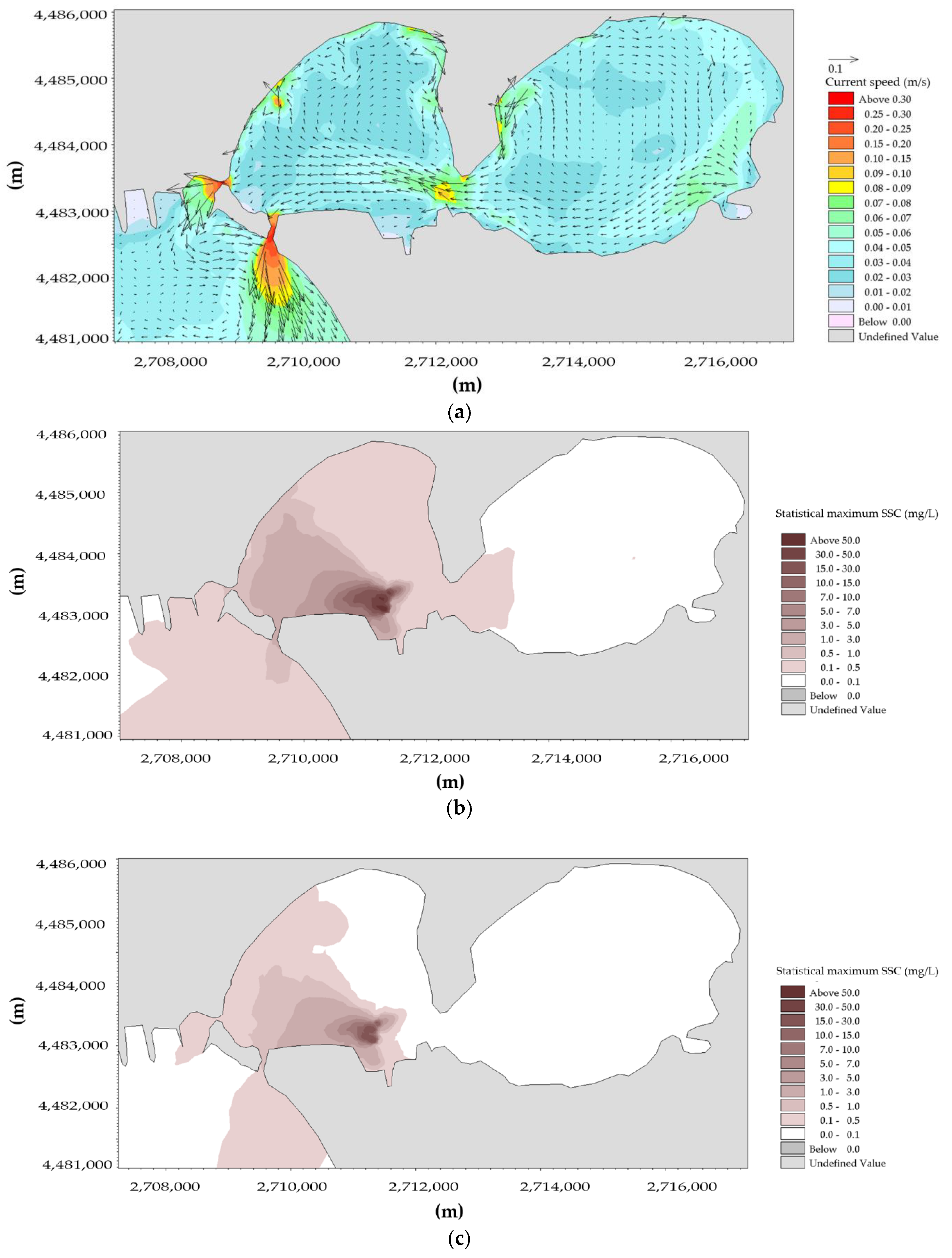
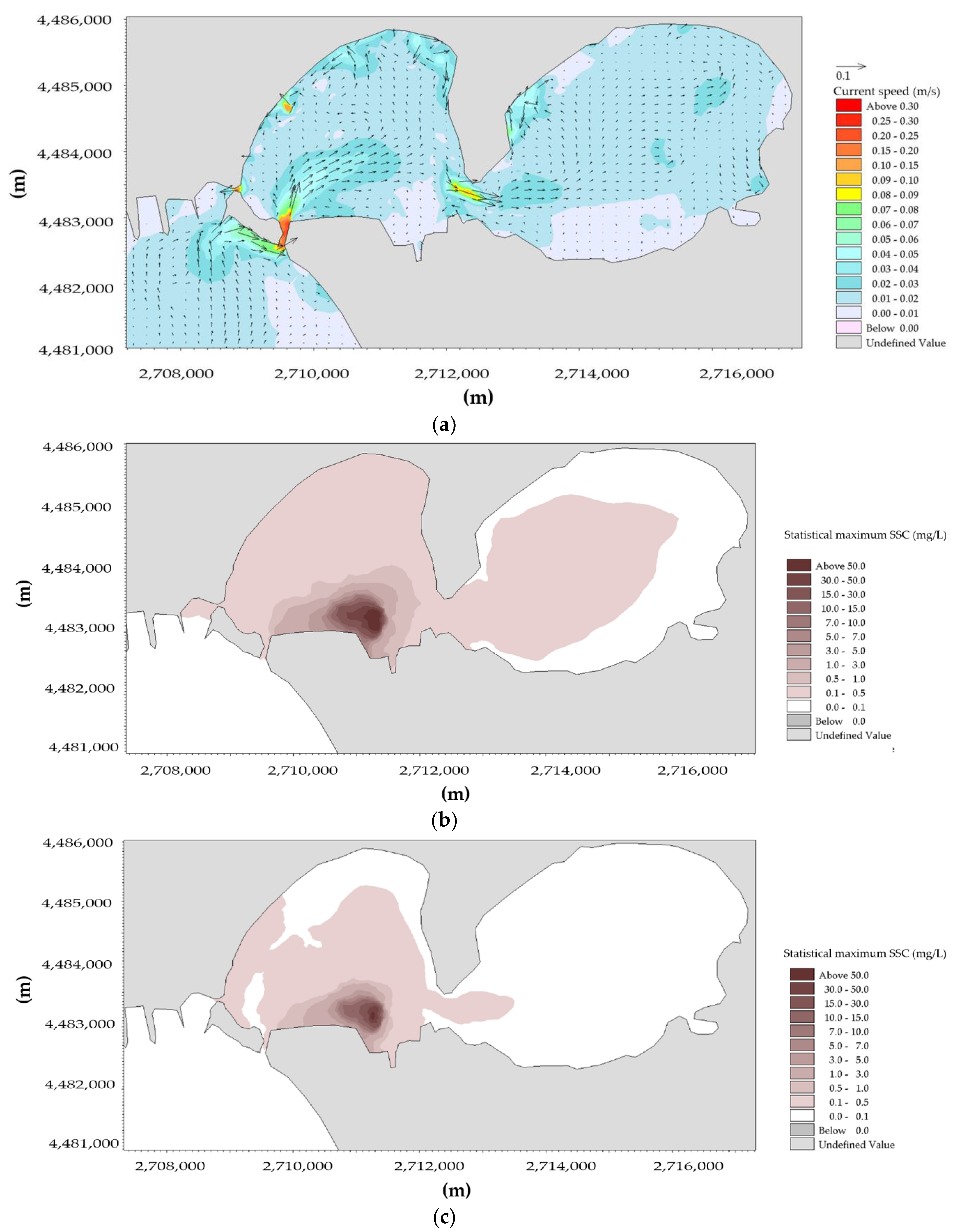
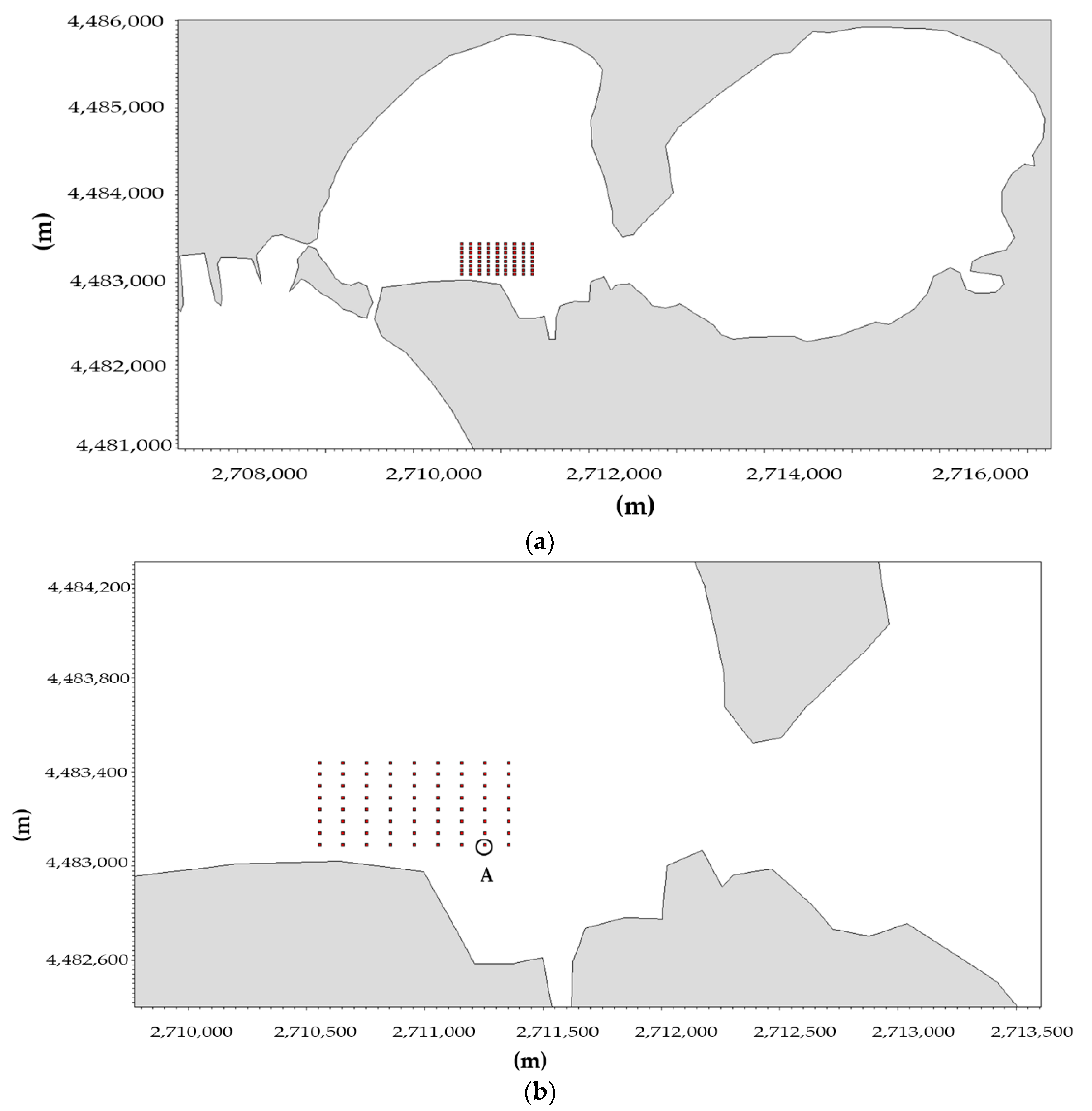

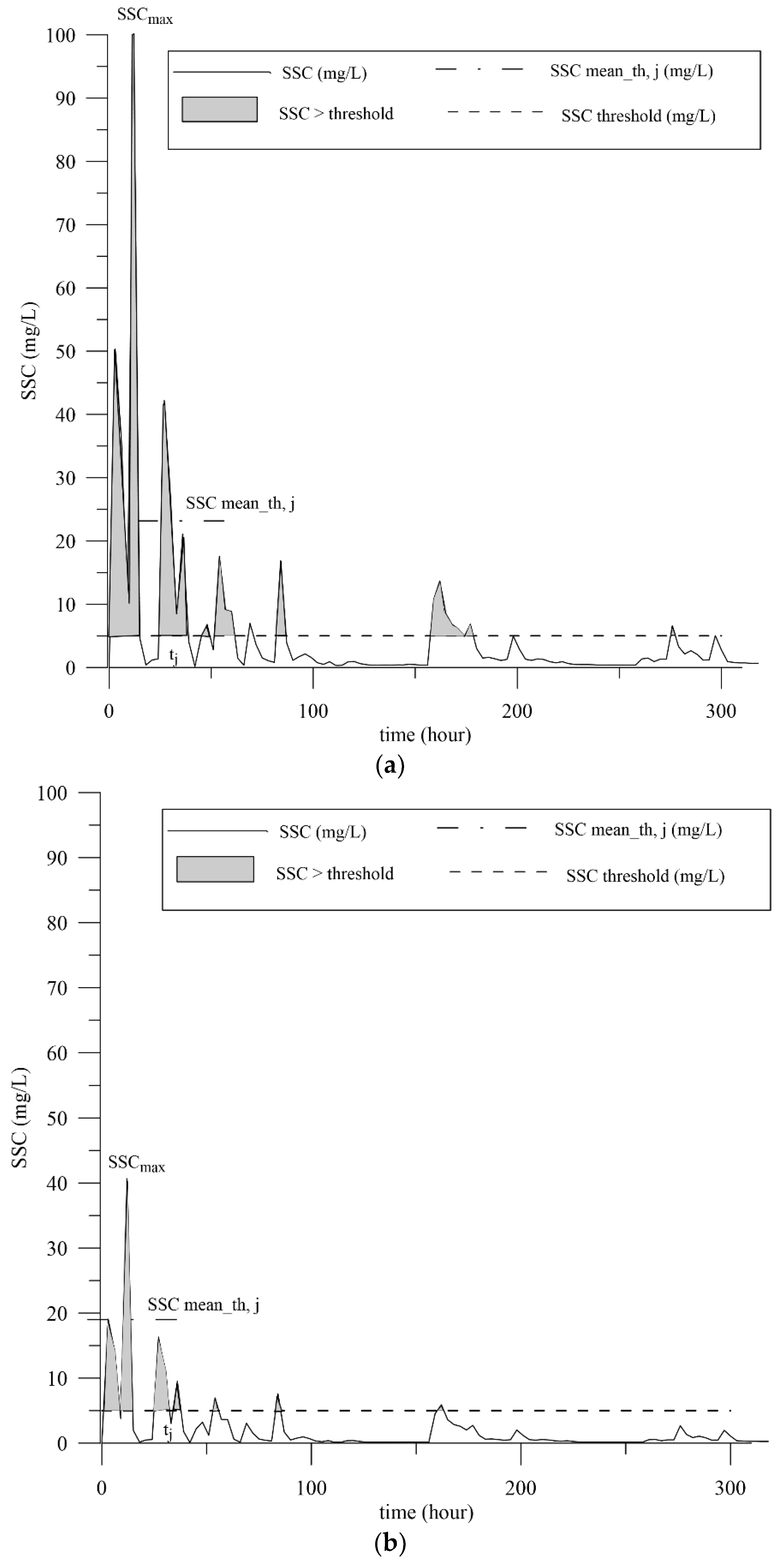
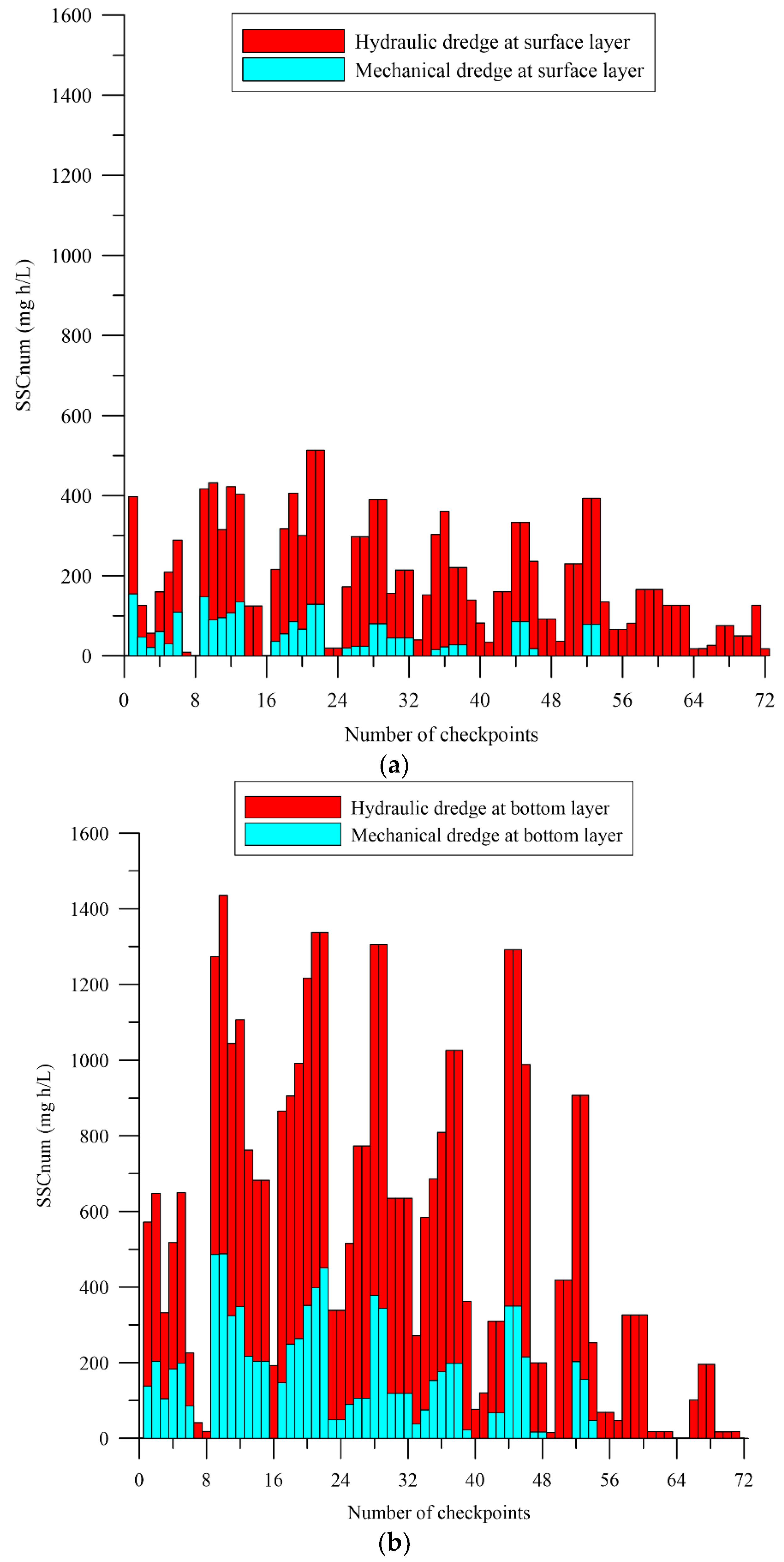

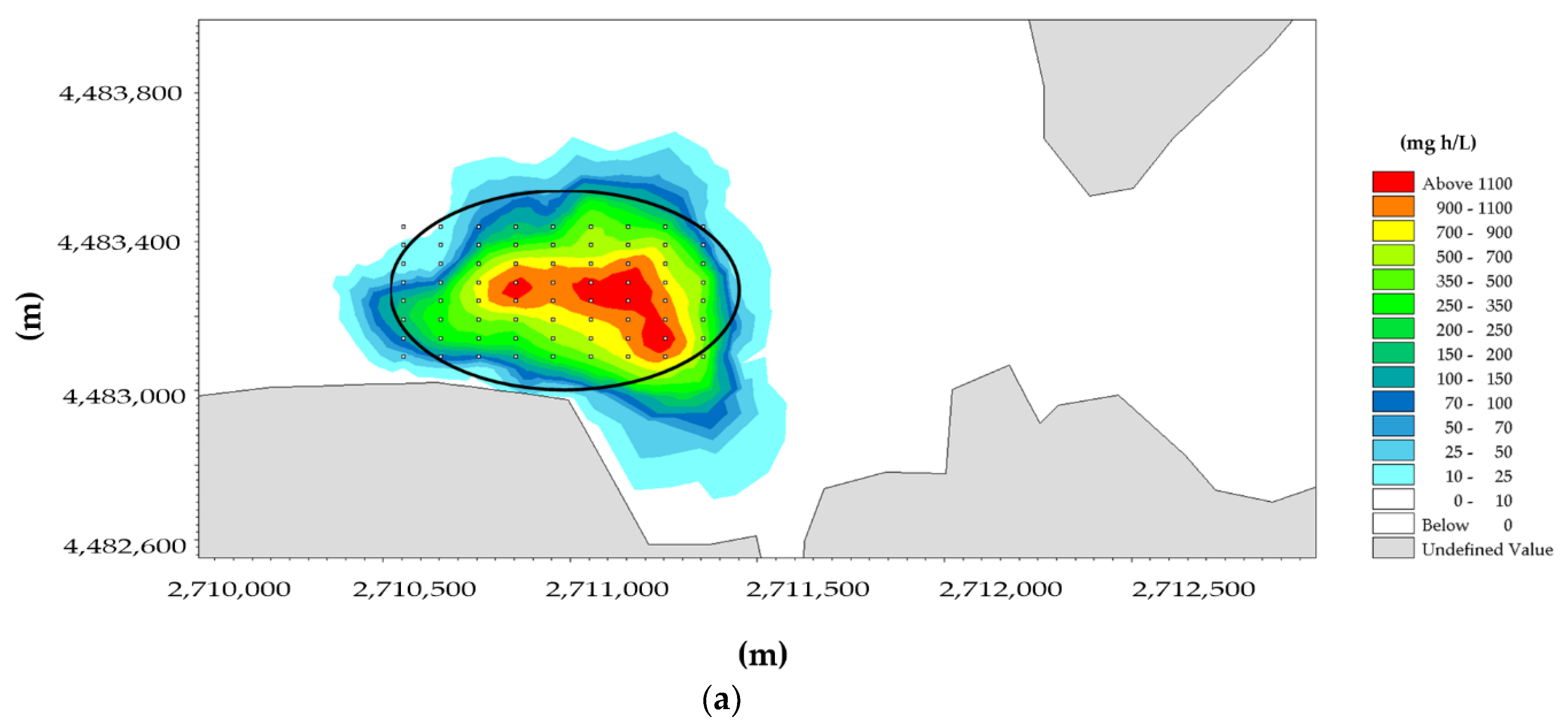
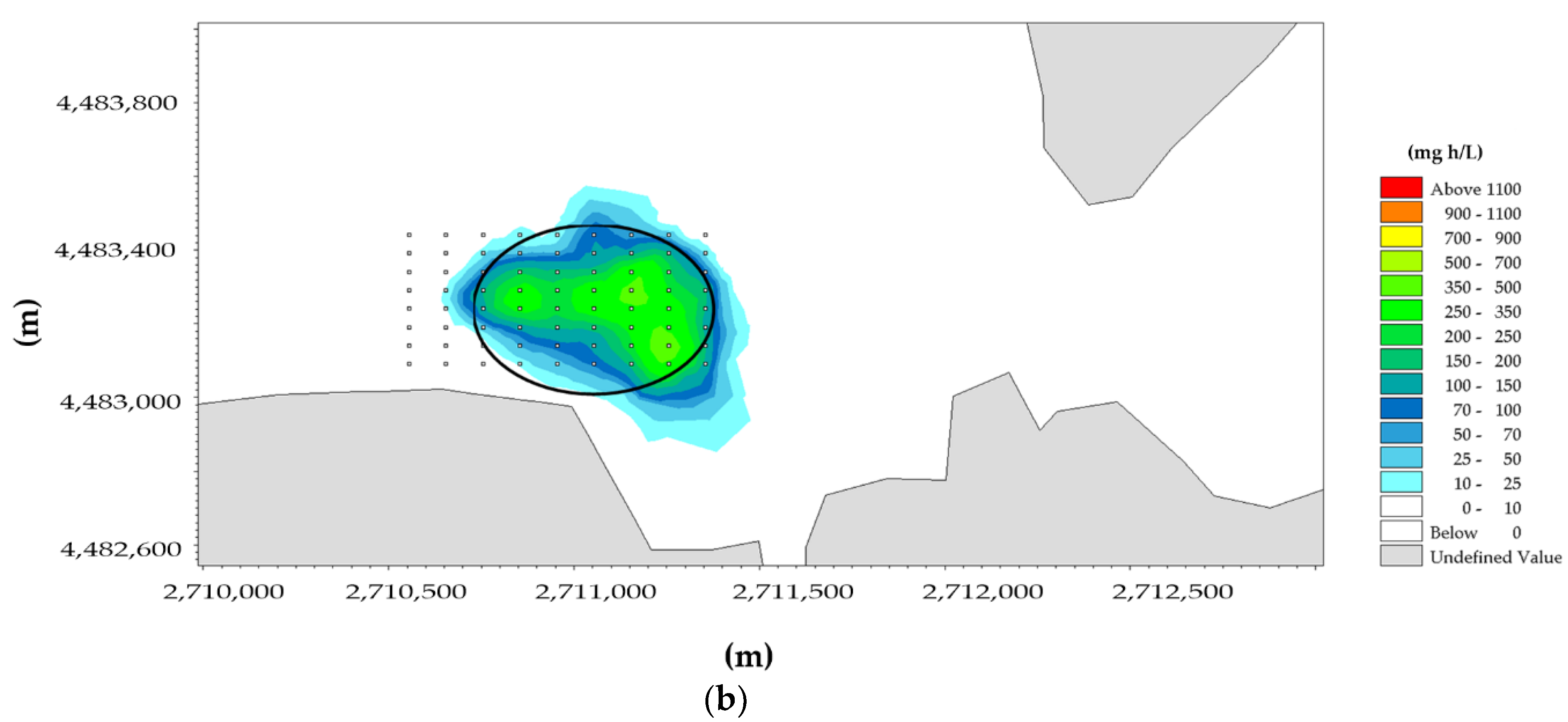
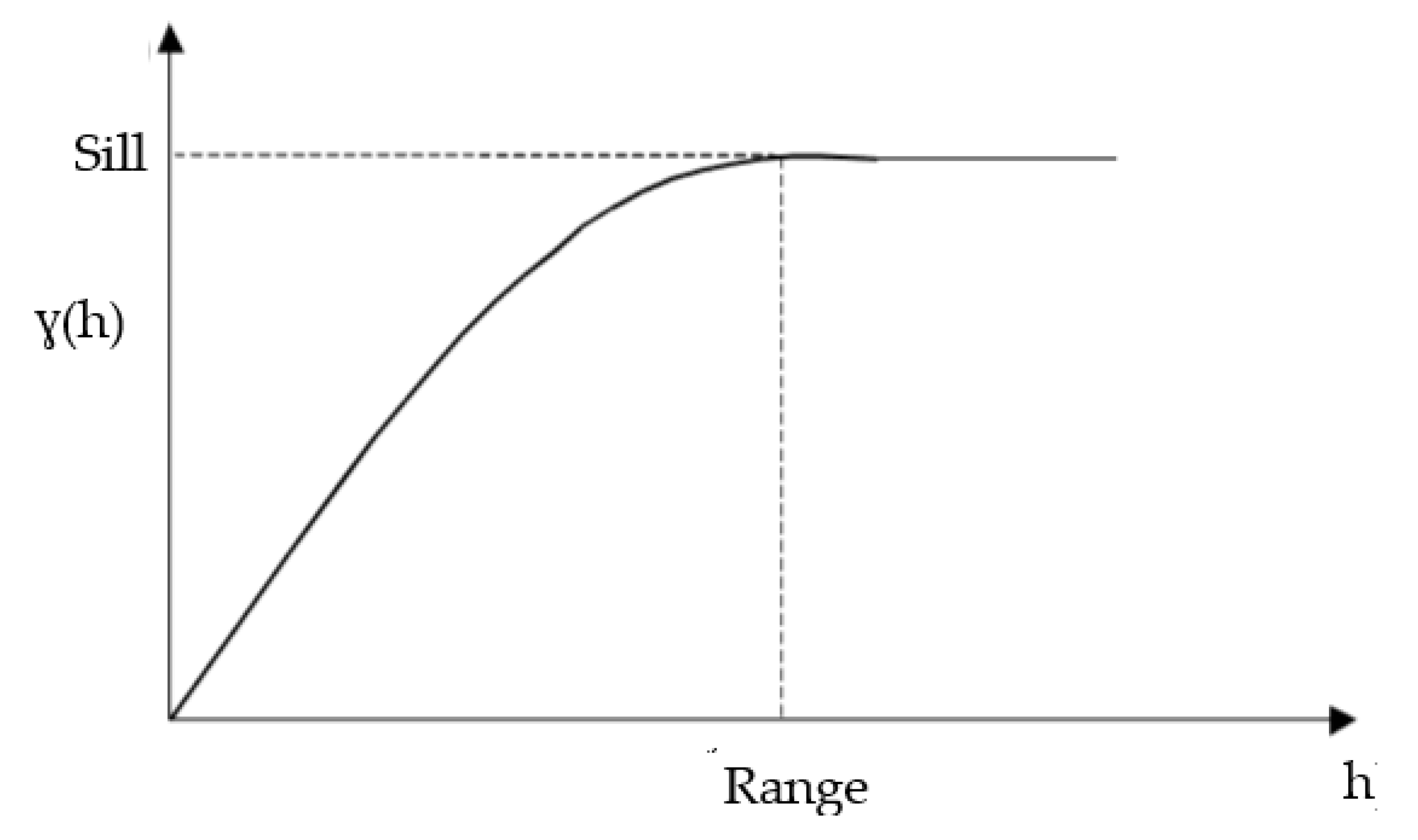
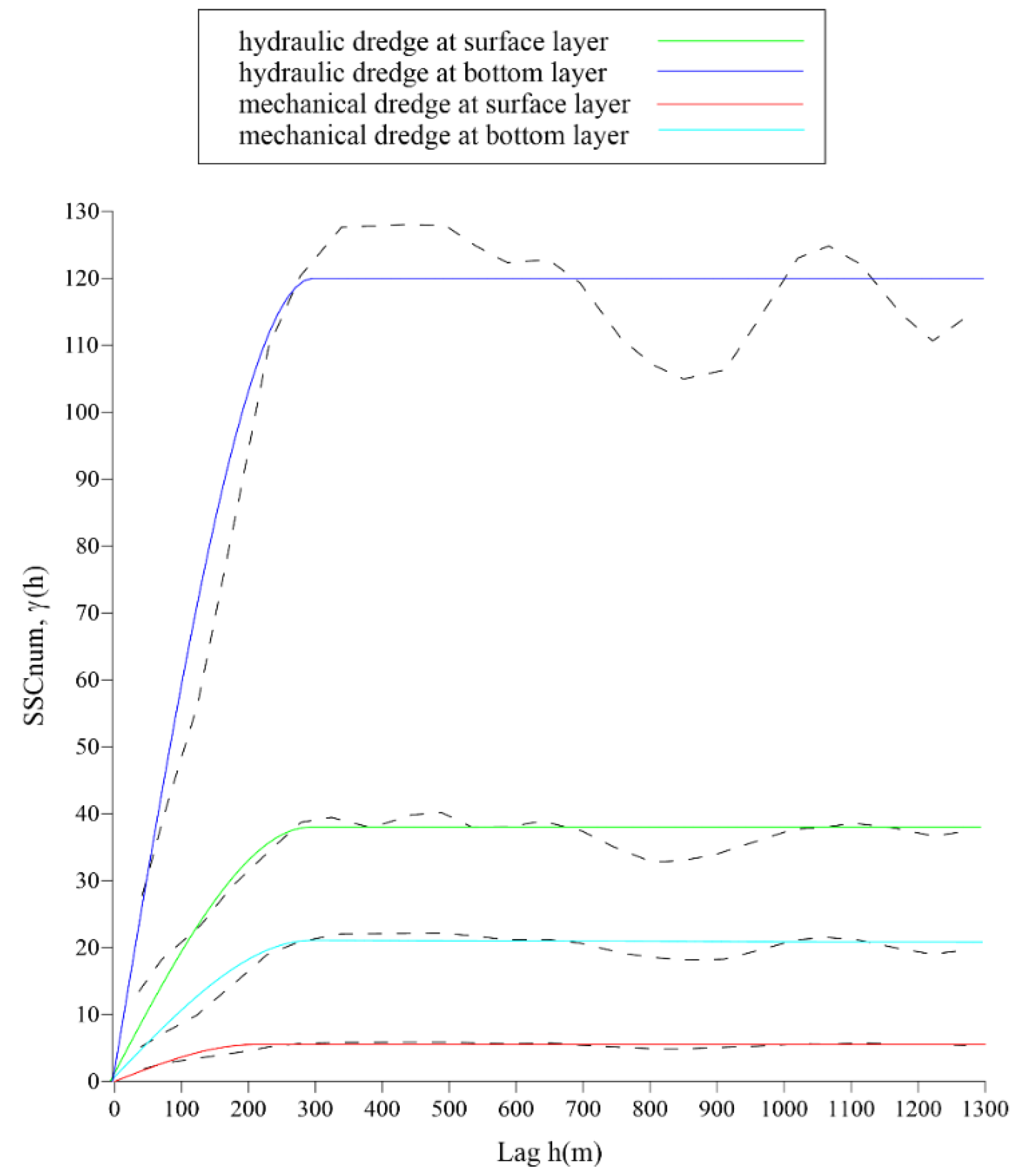
| Parameters | T1 | T2 |
|---|---|---|
| Type of dredger | Hydraulic dredge | Ecological Mechanical dredge |
| Volume to be dredged (m3) | 50,000 | 50,000 |
| Dredging time (d) | 12 | 12 |
| Production capacity (m3/h) | 0.1388 | 0.1388 |
| Mean resuspension factor R (%) | 2.5 | 1.5 |
| Hydraulic Dredge | Mechanical Dredge | |||
|---|---|---|---|---|
| Surface | Bottom | Surface | Bottom | |
| Sill | 37 | 120 | 5.5 | 21 |
| Range (m) | 850 | 1300 | 380 | 700 |
Publisher’s Note: MDPI stays neutral with regard to jurisdictional claims in published maps and institutional affiliations. |
© 2020 by the authors. Licensee MDPI, Basel, Switzerland. This article is an open access article distributed under the terms and conditions of the Creative Commons Attribution (CC BY) license (http://creativecommons.org/licenses/by/4.0/).
Share and Cite
De Padova, D.; Ben Meftah, M.; De Serio, F.; Mossa, M. Management of Dredging Activities in a Highly Vulnerable Site: Simulation Modelling and Monitoring Activity. J. Mar. Sci. Eng. 2020, 8, 1020. https://doi.org/10.3390/jmse8121020
De Padova D, Ben Meftah M, De Serio F, Mossa M. Management of Dredging Activities in a Highly Vulnerable Site: Simulation Modelling and Monitoring Activity. Journal of Marine Science and Engineering. 2020; 8(12):1020. https://doi.org/10.3390/jmse8121020
Chicago/Turabian StyleDe Padova, Diana, Mouldi Ben Meftah, Francesca De Serio, and Michele Mossa. 2020. "Management of Dredging Activities in a Highly Vulnerable Site: Simulation Modelling and Monitoring Activity" Journal of Marine Science and Engineering 8, no. 12: 1020. https://doi.org/10.3390/jmse8121020
APA StyleDe Padova, D., Ben Meftah, M., De Serio, F., & Mossa, M. (2020). Management of Dredging Activities in a Highly Vulnerable Site: Simulation Modelling and Monitoring Activity. Journal of Marine Science and Engineering, 8(12), 1020. https://doi.org/10.3390/jmse8121020








